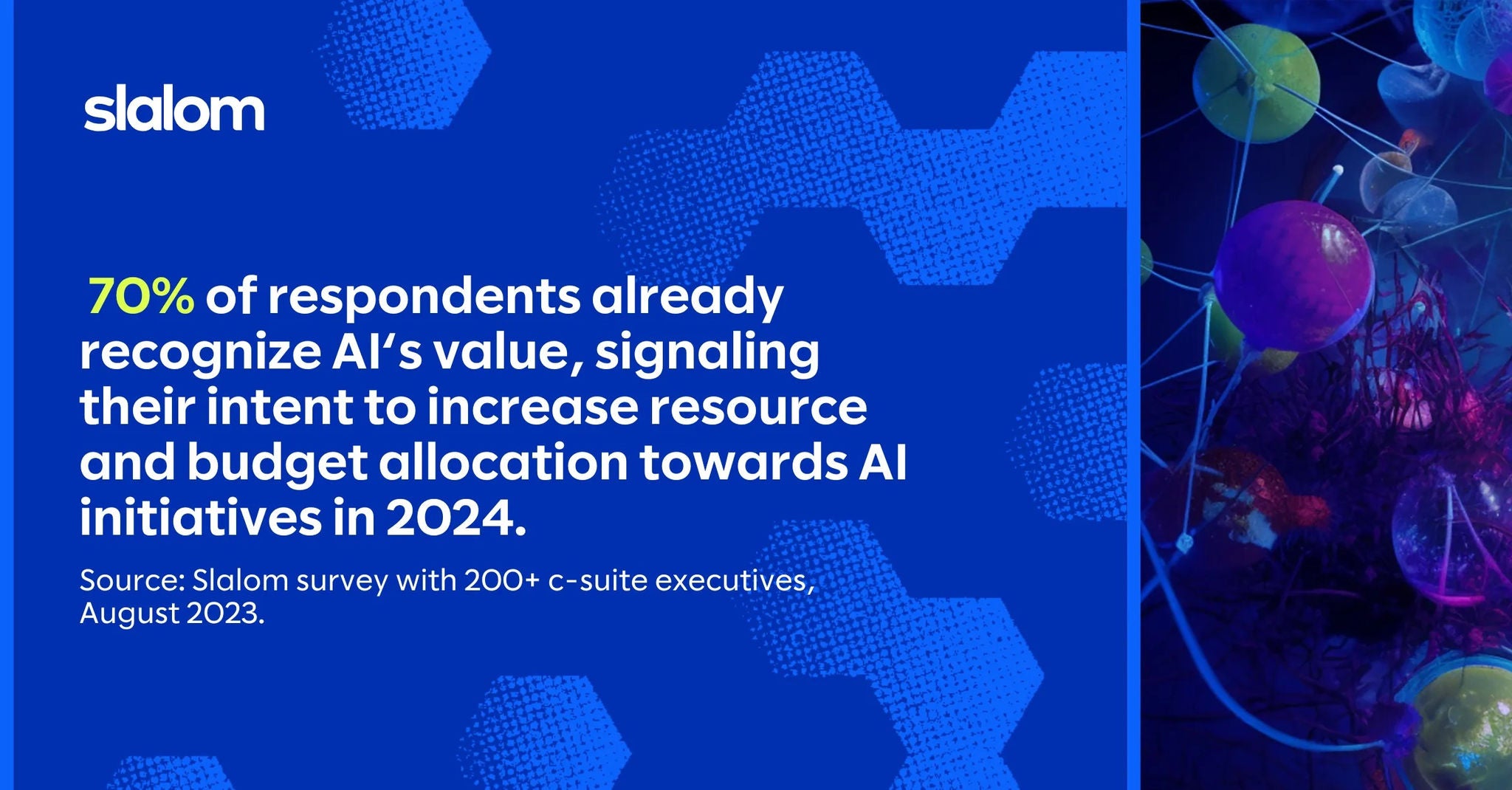Bold blueprints: Rethinking 2024’s strategy

Why 2024’s strategic planning must embrace generative AI
As we reflect on the trajectory of artificial intelligence—especially the transformative power of generative AI (GenAI) in 2023—it’s clear that the past year has been nothing short of a revelation. It wasn’t just about technological advancements but also a shift in the very nature of business strategy execution.
Organizations of all sizes have begun to see GenAI not simply as a mere tool but also as a strategic partner. No longer just a tool for automating tasks, GenAI has become integral to strategic planning processes, offering a depth of analysis and insight that was previously unattainable. It has facilitated a more nuanced understanding of market dynamics, consumer behavior, and operational efficiencies, helping businesses navigate an increasingly complex landscape with agility and foresight.
A true strategic revolution
As we approach 2024, the question isn’t about whether to adopt GenAI but how and where to strategically integrate it. The landscape of business is rapidly evolving, and we firmly believe that to stay ahead, AI insights must be at the heart of any forward-thinking strategy. It’s a transition from reactive adaptations to proactive innovations.
In numerous boardrooms and corporate meetings, “AI” has been discussed, debated, and deliberated. Such conversations have clarified the imperative to transition from bespoke implementations and experimentation to an AI-first approach. In our conversations with senior leaders, we emphasize a pivotal distinction: Is your organization confining itself to foundational AI explorations, or is it deeply committed to realizing AI’s full potential? The difference is profound and can define a company’s future viability and trajectory.
As we step into 2024, integrating AI for strategic planning becomes essential to enhance and expedite our decision-making processes. Concurrently, by channeling AI through strategic planning, we bolster our investments, doubling down on its transformative potential and ensuring we’re not just part of the future but shaping it.
Generative AI’s unbiased lens for 2023’s allocations
In the boardrooms of leading corporations, decisions often teeter between influential leadership opinions and raw data. The challenge? Ensuring that influential voices don’t eclipse data-driven insights. The solution? Enter AI.
AI serves as an invaluable consultant, analyzing past fund allocations with speed and precision. Its true strength lies in its objectivity, stripping away biases and presenting a clear, data-centric view of past decisions. This swift and unbiased analysis offers businesses a competitive edge, enabling them to project forward investments with both accuracy and momentum.
While leadership influence has its merits—especially in shaping organizational culture and vision—relying solely on human inputs and experiences in the absence of data can skew strategic direction. AI balances this equation, ensuring data isn’t overshadowed but stands as an equal counterpart to influence.
Generative AI as strategic consultant and researcher
In the realm of strategic planning, generative AI has emerged as a game changer, adeptly navigating and optimizing specific processes that drive transformative business outcomes. We’ve found great success in including generative AI in the following analytical activities.
- Trend forecasting: Using AI to anticipate market shifts, informing the initial planning phase where businesses set their strategic direction for the upcoming year.
- Scenario modeling: Applying AI to create diverse business scenarios during the formulation stage, enabling the crafting of flexible budgetary and operational plans.
- Innovation ideation: Leveraging AI to brainstorm during the ideation phase, ensuring innovative strategic solutions are budgeted for and prioritized.
- Risk assessment: Utilizing AI during the risk evaluation phase of planning ensures potential pitfalls are budgeted for and allows for strategic contingency funds.
- Resource allocation: Deploying AI during the budget allocation stage, suggesting optimal distribution of funds across strategic and operational initiatives.
- Decision analysis: Integrating AI insights during decision-making, offering clarity when finalizing the budget and ensuring the best ROI for strategic investments.
- Operational efficiency: Harnessing AI to refine strategies during the operational planning phase, ensuring maximum efficiency and cost-effectiveness for the finalized annual budget.
Harmonizing GenAI with strategic mandates
A truism has surfaced through our extensive engagements with corporations: Your AI strategy is fundamentally inseparable from your overarching business strategy. It’s not a mere accessory; it’s integral. As we move toward 2024, corporations must internalize that truth to effectuate the AI acceleration business objectives.
It is now paramount to infuse AI capabilities directly into the core of your operations and strategies, starting with the annual strategic plan. This is not about replacing traditional mechanisms of growth—via other forms of technology, human talent, or reimagined processes—but about harnessing AI to amplify the potential across all these domains. The question for decision makers is clear: Will you allow AI to merely complement or to redefine your strategic horizons?
The unfamiliar terrain of GenAI’s capabilities
While we’ve long been strong advocates for the transformative power of AI, we are also acutely aware of the areas that are still being unearthed. We’re at a stage where the capabilities of AI are expansive, yet some aspects remain nebulous. Recognizing this, we’ve pioneered an innovative approach to uncover true risks to the investment in AI, ensuring that organizations can leverage its benefits with confidence and clarity while developing strategies to work past its current shortcomings.
In light of the expansive—yet sometimes elusive—nature of GenAI’s capabilities, it’s crucial to strike a balance in your strategic investments. In fact, we advocate for allocating a significant portion of such investments to core capability development, where the benefits of AI are tangible and certain to provide immediate acceleration and enhancement. This bedrock of fundamental competencies ensures a strong foundation for your current strategic aims.
While we expend energies on foundational strategic investments, the future beckons with opportunities that may seem peripheral or speculative. This is where future-proofing comes into play: diversify by also earmarking funds for innovative AI opportunities that may reshape industries or create entirely new avenues of value.
These investments are not just about returns; they are crucibles for learning and evolution, essential for driving innovation in subsequent strategic cycles. By thoughtfully distributing funds between the established and the experimental, you secure present-day objectives and position your organization at the forefront of tomorrow’s breakthroughs.

AI integration at every stage of strategic planning
Our recent Slalom survey provides compelling evidence to support the momentum of AI investment and adoption that we’ve observed with our own clients: a significant 70% of company respondents have already recognized the value, signaling their intent to increase resource and budget allocation toward AI initiatives in 2024.
As leaders find themselves at various junctures in their strategic planning processes, it’s imperative to understand how to integrate this emerging technology adeptly. Whether your organization is just beginning, in the throes of planning, or in the execution phase, AI is the linchpin for forward-thinking strategies.
Those yet to embark: Begin with an AI-first lens
Consider this an opportune moment if you’re on the precipice of initiating your strategic planning process. Start with an “AI-first” perspective. Before diving deep into traditional methods, familiarize yourself and your team with the capabilities of AI. Engage with AI experts and consider tailored workshops to understand how AI and generative AI can best serve your specific industry and business model. Beginning with AI at the forefront ensures it’s interwoven seamlessly into every facet of your strategy rather than retrofitting it later.
In the thick of planning: Pivot and integrate
For leaders currently immersed in the strategic planning process, it’s not too late to harness the power of AI. Recognize the areas of your strategy that could benefit from data-driven insights or automation and seek ways to weave AI capabilities into those segments. Collaboration is key here: bring in AI specialists to work alongside your strategy teams, ensuring the integration is smooth and enhancing the planning already in process. It’s a pivot that can dramatically amplify the efficacy of your strategic outcomes.
Post-planning: Augmenting execution with AI
For those who have completed the planning phase and are now in the implementation trenches with their business units, AI is still your ally. While you might have a strategy locked in, the execution can be made more efficient, responsive, and agile with the inclusion of AI. Engage with AI consultants to identify areas of your execution plan that can be optimized. Whether it’s for predictive analytics to better forecast outcomes, automation to expedite processes, or AI-driven tools to improve stakeholder engagement and feedback loops, the technology can be a powerful adjunct to ensure the realization of your strategic vision.
In every stage of strategic planning, the inclusion of AI is not just a recommendation—it’s a competitive imperative. Regardless of where you stand currently, the future is undeniably intertwined with AI, and embracing it today can be the differentiator for leaders and their organizations tomorrow.
This blog post was originally published here.


